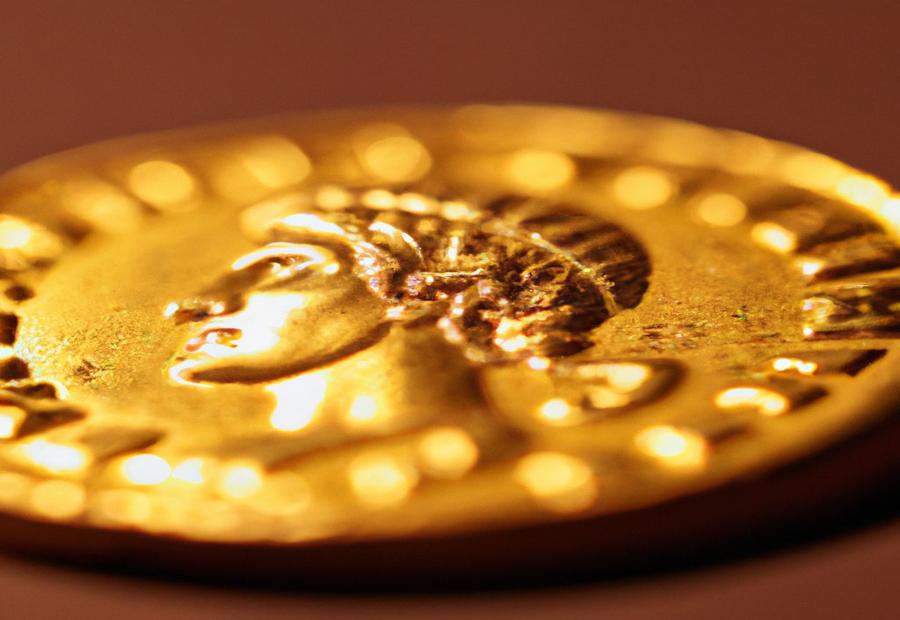Key Takeaway:
- Gold Roman coins hold historical significance, reflecting the culture and economy of ancient Rome.
- Determining the authenticity of gold Roman coins is crucial in assessing their value and avoiding counterfeit or replica coins.
- Pricing and market trends play a significant role in the value of gold Roman coins, influenced by factors such as rarity, condition, and historical demand.
- Collecting and investing in gold Roman coins can be a rewarding hobby, offering a tangible connection to history and the potential for long-term financial growth.
- It is essential to research and educate oneself about gold Roman coins before making any purchasing or collecting decisions.
Introduction
Photo Credits: Ecopolitology.Org by Jacob Hernandez
Gold Roman coins hold not only historical significance but also a certain monetary value. In this article, we will explore two key aspects related to these coins: the historical significance they carry and the methods to determine their authenticity. By delving into these matters, we can gain a deeper understanding of the worthiness and importance of gold Roman coins.
Historical Significance of Gold Roman Coins
Gold Roman coins are of immense historical importance. They symbolize the power and wealth of the Roman Empire. These coins give us a great insight into the politics, economy, and culture of that period. They are tangible artifacts of the grandeur of the Roman civilization.
Moreover, gold Roman coins have important figures and events embossed on them. Each coin is a tribute to the rule of the emperors and their contributions to Rome’s progress. The images on the coins are of famous leaders like Julius Caesar, Augustus, and Hadrian, thus giving us an insight into their legacies.
Related Post:
how to convert 401k to gold ira
How Much Is a $25 Gold Piece Worth
How Much Is 100LBS of Gold Worth
In addition to their artistic value, gold Roman coins also signify economic stability and clout. By minting gold coins, the Romans showed their financial strength in global trade. These gold coins were widely accepted as currency throughout the empire, strengthening Rome’s hold in commerce.
To comprehend the historical worth of gold Roman coins, one must understand their part in our knowledge of ancient civilizations. Through meticulous research and analysis, experts have gained insights into social structures, trade networks, and even historical events from these detailed artifacts.
It is clear that gold Roman coins have a unique place in history. The conservation and study of these ancient treasures give us the opportunity to explore the secrets of an empire that once held sway over wide territories. Their value goes beyond their monetary worth; they are gateways to a vanished era that still fascinate scholars and collectors.
Determining the Authenticity of Gold Roman Coins
In order to assess the authenticity of Gold Roman Coins, multiple factors must be considered. For instance, the historical significance and cultural context of the coin should be examined. Additionally, design elements, weight, and size should be compared to known examples from reputable sources. The metal composition and purity of the gold used should also be verified. Moreover, other unique details, such as inscriptions or wear patterns, should likewise be taken into account. Tracing a coin’s provenance and employing advanced scientific techniques like X-ray fluorescence analysis may also be beneficial. By combining these different methods, collectors and investors can confidently determine if a Gold Roman Coin is genuine or not.
The Value of Gold Roman Coins
Photo Credits: Ecopolitology.Org by Zachary Thompson
Gold Roman coins hold a fascinating history and captivating allure, but what exactly determines their value? In this section, we will explore the factors that contribute to the worth of these ancient treasures. From examining the pricing dynamics to understanding the ever-evolving market trends, we’ll uncover the secrets behind the value of gold Roman coins. Sit tight as we delve into the intriguing world of numismatics and the captivating stories these coins whisper from centuries ago.
Pricing and Market Trends of Gold Roman Coins
Gold Roman coins have always been of historical significance. To know their value, and market trends, it’s essential to authenticate them. This has caused demand for such coins, leading to pricing strategies and market trends.
Analyzing the data helps in understanding these trends. Rarity, condition and history of the coin can be considered to determine its worth. Examining auction results can show market trends.
Creating a table to compare different coins based on their attributes and prices is helpful. The table should include columns for coin type, condition, history, rarity and price range. This gives individuals insight to make informed decisions.
Pricing data and market trends give an idea of coin value, but other factors may affect it. Changes in numismatics or newly discovered info about historical events regarding coins may cause this. Staying updated on news and research helps in understanding trends.
An example of how unpredictable collecting gold Roman coins can be – a collector found a seemingly unremarkable coin at a flea market. It turned out to be from Emperor Nero’s reign and was worth over $50,000!
Collecting and Investing in Gold Roman Coins
Photo Credits: Ecopolitology.Org by Albert Sanchez
Gold Roman coins can be a profitable and alluring pursuit. These antiquated objects have cultural and historical worth, making them much sought after by collectors and investors. The worth of a gold Roman coin can differ greatly depending on variables such as its rareness, condition and historical importance. Certain gold Roman coins can fetch thousands or even millions of dollars at auctions or through private sales.
When considering collecting and investing in gold Roman coins, it is essential to be aware of certain unique details. The desirability and value of individual coins can be influenced by factors like their provenance, prior ownership and historical importance. What’s more, developments in technology and archaeological discoveries can affect the availability and market for gold Roman coins. Keeping informed about these aspects can help collectors and investors make informed decisions and explore the dynamic world of acquiring these valuable artifacts.
Conclusion
Photo Credits: Ecopolitology.Org by Mark Rodriguez
To conclude, a gold Roman coin’s value can differ drastically. This depends on many elements – the coin’s scarcity, state and the market’s interest in ancient coins. Also, the coin’s historic importance contributes to its worth. So, collectors and investors consider these factors carefully when estimating the coin’s worth. Hence, research and expert advice are necessary when evaluating a gold Roman coin’s value.
Some Facts About How Much Is a Gold Roman Coin Worth:
- ✅ The most expensive Roman gold coin ever sold was a 1,700-year-old coin depicting the face of Allectus, which sold for $700,000. (Source: Artnet News)
- ✅ This coin was estimated to be worth $90,000 to $127,000 but sold for five times its estimate. (Source: Artnet News)
- ✅ Only 24 coins depicting Allectus exist in the world, with the British Museum owning the only other example cast from the same dyes. (Source: Artnet News)
- ✅ Another record-breaking Roman coin is the gold version of the ‘EID MAR’ denarius of Brutus, which was sold for approximately 2.7 million pounds. (Source: CoinsWeekly)
- ✅ The ‘EID MAR’ denarius of Brutus represents the assassination of Caesar on the Ides of March and is highly sought after due to its rarity. (Source: CoinsWeekly)
FAQs about How Much Is A Gold Roman Coin Worth
How much is a 1,700-year-old Roman gold coin worth?
The estimated price of the 1,700-year-old Roman gold coin depicting the face of Allectus, a finance minister in Roman Britain, was $90,000 to $127,000. However, it was sold at auction for a record-breaking sum of $700,000, five times its estimate.
Who discovered the 1,700-year-old coin?
A 30-year-old British man found the 1,700-year-old Roman gold coin in a field near Dover, Kent, using a metal detector.
How rare is the 1,700-year-old Roman gold coin?
Only 24 such coins exist in the world, with the British Museum owning the only other example cast from the same dyes.
Who bought the 1,700-year-old Roman gold coin?
An unidentified buyer placed the final bid of $700,000 by telephone at the auction.
What is the significance of the coin’s motif?
The motif on the coin represents the assassination of Caesar on the Ides of March (EID MAR), with Brutus depicted on the obverse and two daggers and the pileus depicted on the reverse. The pileus is a felt cap worn by freed slaves, symbolizing the assassins’ belief that killing Caesar was a heroic act to preserve the Republic.
What is the most expensive Roman coin ever sold?
The most expensive Roman coin ever sold is the aureus of Brutus, a rare gold version of the ‘EID MAR’ denarius, which was sold for a record-breaking sum of 2.7 million pounds (approximately 2,988,360 euros) at the Roma Numismatics Auction XX.

.jpg)



